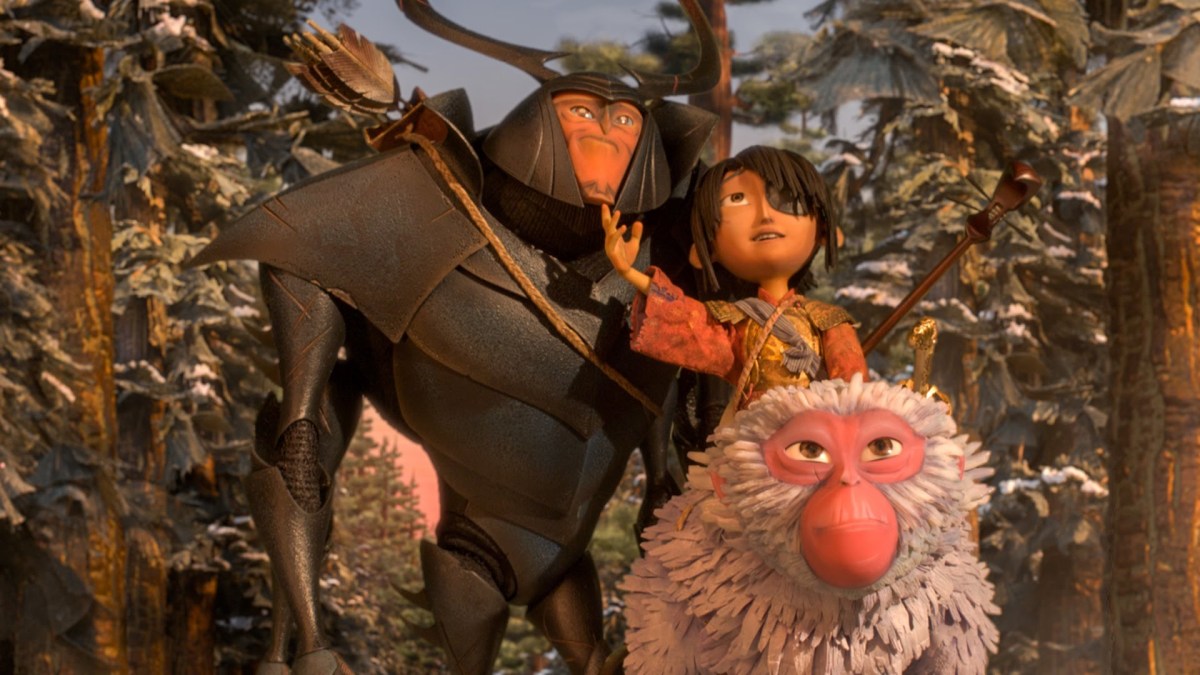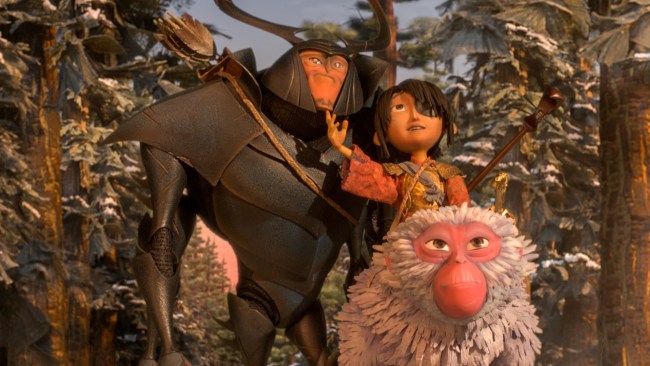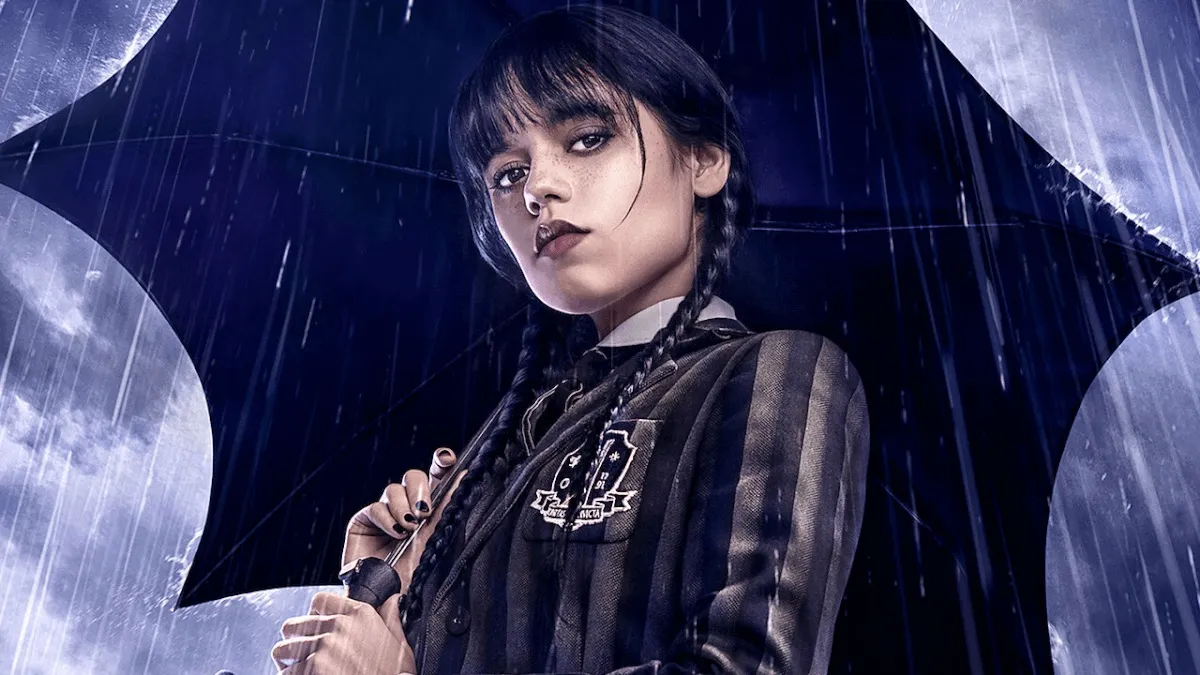Kubo and the Two Strings is LAIKA’s fourth animated film, which just so happens to be arriving during the company’s tenth anniversary year. It’s a huge milestone for the company, as Kubo represents not only techniques and storytelling that LAIKA has never tried before, but also things that have never before been tried in stop-motion animation. At the center of it all is Travis Knight, who is not only the President and CEO of LAIKA, but is also making his directing debut with Kubo.
The film tells the story of a young boy named Kubo (voiced by Art Parkinson) who, with his creativity and the help of a magical shamisen, can tell stories by bringing the inanimate to life. He then embarks on a journey with Monkey (Charlize Theron) and Beetle (Matthew McConaughey) that allows him to learn more about his family, his history, and himself.
I had the chance to speak with Knight, and learned that Kubo and the Two Strings is an incredibly personal project to him, informed by his own childhood experiences. While the screenplay was written by writer Marc Haimes, the film’s story was from an original idea by Character Designer Shannon Tindle, and the film’s story was developed over the course of several years by the entire team at LAIKA, it is chiefly informed by Knight’s story. From his “jet-setting entrepreneur” father (and owner of LAIKA, Phil Knight) taking him to Japan as a child, to his mother’s love of fantasy epics, Kubo ended up becoming both a love letter to beloved interests from Knight’s childhood, and a love letter to his relationship with his parents.
Teresa Jusino (TMS): Where did the idea for the story of Kubo and the Two Strings come from? How did it evolve?
Travis Knight: I think back to when we first started LAIKA ten years ago, and our mandate at the time was deceptively simple. We wanted to make movies that matter. We wanted to tell beautiful, rich, and evocative stories that honor tradition while looking toward the future. To take animation where it really hadn’t been before.
And so, it was about five years ago we were knee-deep in production on ParaNorman. And the original idea for the story sprang from the fertile mind of our brilliant character designer, Shannon Tindle, and even though it was early and raw, the original pitch…there was something about it that was really exciting and evocative. Stripping it down to its most reductive state, the idea of a stop-motion samurai epic was something that was really cool. It was something that we’ve never seen before. And my mind just starts reeling with all the opportunities for something like that.
And it spoke to me on a number of different levels. When I was a kid, it’s probably no surprise that I was a big nerd, and I loved big, epic fantasy stories. In fact, when my mom was pregnant with me, she was reading Tolkien’s Lord of the Rings. So, when I was born, it was in the air with my first gasp of breath. The Tolkien was floating around the room, and when she was recovering, that was the book she was reading. So, that was one of the many gifts that my mother bestowed upon me was this love of fantasy. So, I loved Tolkien, I loved Star Wars, I loved Lone Wolf and Cub, and the films of Ray Harryhausen and Akira Kurosawa.
And so, with a movie like this, it was like a blank canvas that we could paint in those same colors, that we could try to tell a story that was an epic fantasy. And we had never done that before, probably for good reason. They’re really hard to do, particularly the way we make movies. You know, we have a big warehouse with slabs of wood that are the sets. With a fantasy, you need sweep, you need scale, you need scope, and that’s something we don’t have! We shoot really small. So the idea that you could make a stop-motion David Lean film in a warehouse was a bit daunting. But we were excited by that challenge.
To go back, when I was a kid, I started falling in love with stop-motion animation. I absolutely loved it. But at the same time, I took my first trip to Japan with my father. I grew up in Portland, Oregon, and I’d never experienced anything like what I did when I was in Japan. It opened my eyes to something that I never even knew existed. It was so beautiful, it was so breathtaking. It really captivated me, and it was so completely different from anything I’d experienced. And you saw it in everything: you saw it in the buildings and architecture, in the art, in the style of dress, in the movies, in the music, in the comic books. And I came back with this whole big bag of manga comics. And even though I couldn’t read the language, there was something so rich about the visual storytelling that you could understand what was happening.
That began my love affair with the transcendent art of this great culture. I went back many times with my father, and then as a grown-up I’ve gone back as well. This film, it was like all those things wrapped into one. It was all those things I loved deeply as a child in one thing. The great filmmaker Zhang Yimou said that every boy either wants a train set, or to make a great martial arts movie. And I never had a train set. [laughs]
So, you start with this great idea, and you start developing it and nurturing it, and then you start to see parallels between your own life and your characters, which is always a shocking thing when you start seeing yourself come through in these characters. And like a sculptor, you look for the sculpture inside the stone. That’s happened with this story. And it wasn’t until much later in the process that I realized that Kubo is like I am. He is an artist, he’s a musician, he’s a storyteller. He’s an animator, when you really think about it — he takes these simple objects, and through his will and his creativity, he transforms them into living things, which is all an animator does. Also, his experience with his family. His experience with his mother, and how she’s the center of his universe, and how those things began to shift, and this journey he goes on as he becomes an adult. Those were all heightened things from my own life experience. It really felt like this was an opportunity for me to…I felt like I could really contribute something to this story in a meaningful way.
TMS: I noticed at the end of the film that there were “Thank Yous” to places like the Japanese Museum, and I was wondering about research into the cultural side of stuff. I have to say, you see a bunch of white guys telling a story about Japan…and it’s odd to see! [laughs] You would naturally expect a story like this to come from someone who is Japanese. So I was just curious about your research process and your relationship to the cultural aspects of this story.
Knight: Any time that you are looking outside of your own experiences, you want to make sure to capture it as accurately as possible. So, we did a heavy amount of research, and we brought in a lot of consultants and experts. If we weren’t experts in a field, we found people who were. We went to a lot of museums, our costume designer went to Tokyo to research fabrics.
I don’t think it’s weird, and I’ll tell you why I don’t think it’s weird. Art is one of those few things that crosses cultural barriers. Art is one of those things that brings us together, and thank God for that. Art is one of the few things that can transcend and remind us that we’re all one human community. For instance, you can just look at the influences on this movie for us. One of the biggest influences for us was Akira Kurosawa. But Kurosawa was heavily influenced by the Bard, by William Shakespeare, a white guy who lived in England hundreds of years prior. His work spoke to Kurosawa deeply. If you look at Throne of Blood, it’s essentially Macbeth. If you look at Ran, it’s King Lear. And even Yojimbo was inspired by a Dashiell Hammett novel.
I think there’s an overlapping sphere of influence where artists are inspired by different things, and different things speak to them. And I think that’s a beautiful thing. I think that’s an extraordinary aspect of what it means to be human, that people who are outside our own experience can do something that resonates with us deeply. That’s what this film means for us.
TMS: Switching gears for a moment, I loved the voice performances in this by Art Parkinson, Charlize Theron, and Matthew McConaughey, and these are all actors that are primarily known for live-action. Talk a little about what it was like working with them, and getting those performances out of them.
Knight: Performance in animation is way different than live-action. In animation, the physical side of acting is the preserve of the animator. That’s what they provide. The only thing the actor can do to bring emotion to their character is their voice. So, often times, when we’re thinking about casting, we pull clips from films, and we pull clips from interviews they’ve given, so we can hear how their voices sound naturally. And we put that against designs of the characters to see if it fits. And like an orchestra, you try to arrange it, because you want each voice to have its own unique sonic signature.
It’s interesting, because often times people you think are great actors — and they are — when you extricate their voice from what they can do physically, the voice isn’t the most powerful side from what they can do. That’s always an eye-opening thing for us. So, we wanted the finest actors in the world for this movie. We don’t do films that play to the cheap seats. We don’t want to just have over-the-top, showy performance, we want a real, beautiful, naturalistic performance.
And so, when we started thinking about Charlize and Matthew, Charlize’s character Monkey is basically the strength of a mother’s love without the tenderness. Of course, as you get to know her, you find out that she has a huge amount of vulnerability and sweetness, and she cares deeply for this boy. With Matthew, he’d never really acted in animation before, so it was a different kind of a process.
To see how they need to physically get themselves up for delivering the performance that they want, to capture the quality of their voice. And it’s really incredible, because as an animator, we approach things differently. We always approach things with Okay, what’s the emotion the character’s feeling? And then, How can I make a gesture that will make it look like they are feeling that emotion? With the actors, the opposite is true. It was often, What’s the physical thing that I can be doing to get me to that emotional state? It’s an amazing thing to witness, and it’s a completely different way of working that I wasn’t used to, so it was a great collaboration, and they give beautiful performances. They really bring these characters to life.
Kubo and the Two Strings hits theaters on Friday! For more info, check out TMS’ Allyson Johnson’s review of the film, which posted earlier today.
Want more stories like this? Become a subscriber and support the site!
—The Mary Sue has a strict comment policy that forbids, but is not limited to, personal insults toward anyone, hate speech, and trolling.—
Follow The Mary Sue on Twitter, Facebook, Tumblr, Pinterest, & Google+.










Published: Aug 15, 2016 05:15 pm